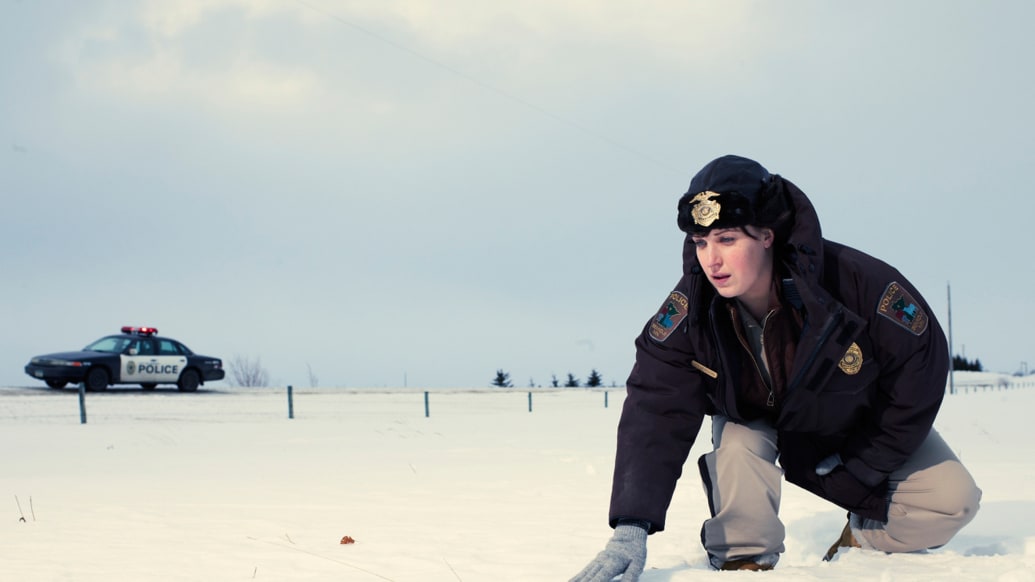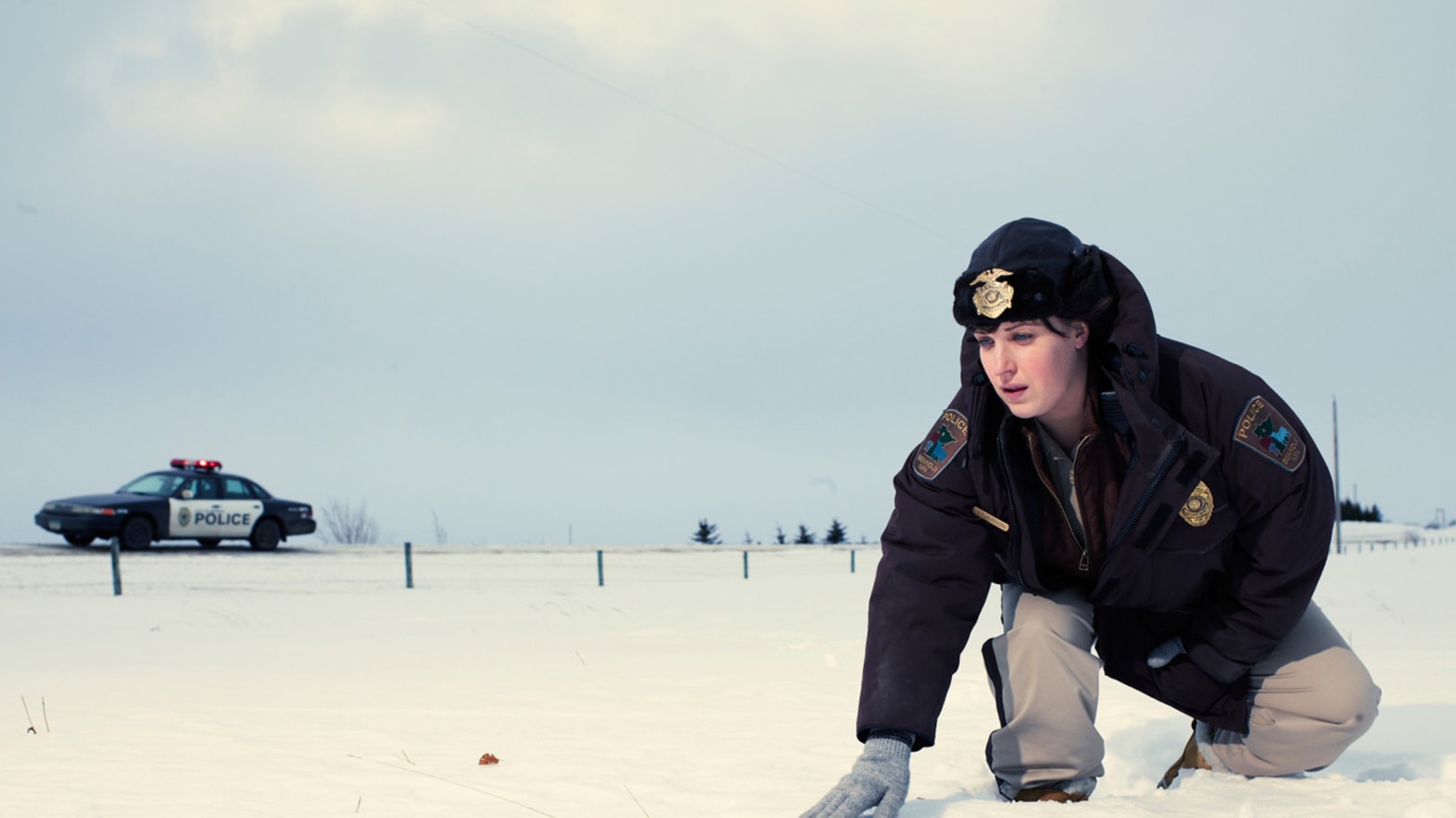There’s something unsettling—and maybe a little exciting—about being on the set of Fargo and hearing the full whirring of a machine starting off the distance. The mind goes to one place: the wood chipper.

Alas, no one was being ground up into bloody membrane and morsels of flesh—that day, at least—during the shooting of FX’s ambitious, risky, and some might even say sacrilegious limited series adaptation of Joel and Ethan Coen’s 1996 iconic film. It was just an unseasonably warm day in Calgary, and a fake snow machine was being revved up to help recreate the frigid feel of the setting the Coens described to new Fargo writer Noah Hawley as “Siberia with family restaurants.”
Hawley has thought a lot about how the Coens would describe things on the set of the show he’s been tasked with writing. In his own words, he’s “the writer who dared.” He’s either the bravest man in show business or the biggest fool, the one who accepted the challenge of adapting for TV a film that has appeared on AFI’s list of 100 Greatest Movies, was nominated for Best Picture at the Oscars, and is considered by many film buffs to be, simply, perfect.
More than your average cable series launch, then, there are keen eyes on FX and Hawley, if nothing else to make sure that the 10-episode series—packed with a cast featuring Billy Bob Thornton, Martin Freeman, Colin Hanks, Bob Odenkirk, Keith Carradine, and breakout star Allison Tolman—doesn’t tarnish the Coen Brothers’ creation, which is as good as frozen in time as a movie masterpiece as if it had been dropped in Fargo’s glacial Minnesota lakes.
“You don’t want to be the guy who ruined the Coen Brothers,” he says. “It’s like kicking the pope.”
Do Hawley and company pull off the feat unscathed, no popes kicked? You betcha. Though there may still be plenty of people willing to chuck them into the wood chipper for even trying. Even the new Fargo’s cast took some convincing that this endeavor was a good idea.
“My first thought was, ‘God, does the world need that?’” says Martin Freeman, shedding all memory of his indelible work as Bilbo Baggins in The Hobbit and Watson in Sherlock while speaking with the gee-golly Minnesowtah accent he maintains while on set. “Because if it was a pale imitation, then the world definitely does not need that.”
A perfectly mixed cocktail equally parts menacing and suspenseful, washed down with surprising notes of hilarious satire and pulpy violence, FX’s version of Fargo is most certainly not a pale imitation of the gruesome dark comedy. If not an imitation, though, then the question on many minds is: What exactly is it?
For one, it’s a 10-episode limited series, which means it’s basically a mini-series, with the option for FX to extend its run into an anthology series, a la American Horror Story, that can change characters and story lines from season to season. Billy Bob Thornton, explaining the biggest appeal of the project for him, calls it, with a glint in his eye, “a 10-hour movie.” But it’s the series’ connection to the original film, and the Coens’ actual involvement with it, that’s sparking the most confusion.
What FX’s version of Fargo is not is a recreation or remake of the 1996 film, which saw Frances McDormand’s intrepid pregnant police chief Marge Gunderson—a cinema icon if there ever was one—investigating a series of local homicides, and their connection to Jerry Lundegaard, the unassuming Minnesota car salesman in over his head after hiring two criminals (played by Steve Buscemi and Peter Stomare) to kidnap his wife so he could collect the ransom.
The Fargo limited series collects everything from the universe the Coens created in 1996 and shifts it all slightly to the left. It’s still a true crime story. A car accident launches the narrative. There’s still a doggedly determined female police officer, but this time it’s dutiful upstart Molly Solverson (Allison Tolman) instead of whiz investigator Marge. Martin Freeman’s Lester Nygaard is an insurance salesman, assuming the plot function of Macy’s Lundegaard, and it’s Billy Bob Thornton’s enigmatic baddie Lorne Malvo who this time brings him to the dark side.
Most importantly, the appallingness and the hilarity that made the Coens’ Oscar-winning script so special hasn’t gone anywhere. “Noah’s just ramped off the movie in the most brilliant way,” says Keith Carradine, who plays Molly’s father, a retired police officer. “It’s just slightly off from the movie, which is slightly off itself.”
(Full disclosure: FX covered the travel expenses on my trip to Fargo's set. A worshipper at the altar of Coen, I arrived in Calgary skeptical and ready to be hard on the show, at the very least to prove my editorial independence. But then something funny happened, don't ya know: the new Fargo turned out to be great.)
The end result is a series that feels a lot like Fargo—a warm familiarity needed to weather the setting’s chill—but is wholly original. Joel and Ethan Coen gave FX their blessing, based on the pilot script, and are executive producers, but have little to no day-to-day involvement. What FX is offering, then, is a new series that feels like a Coen Brothers movie.
Fittingly, the TV show’s existence is all thanks to snow. Well, thanks to a snow globe.
***
Former NBC Entertainment President Warren Littlefield distinctly remembers a day in his office back in 1997, when he received a snow globe from legendary producers Bruce Paltrow and Robert Palm. Inside was a tiny recreation of Marge kneeling next to an overturned car and blood in the snow, the lasting opening scene of Fargo. They wanted to turn the film into a series, but Littlefield ultimately passed on the script.
One year later, CBS actually shot a pilot of a Fargo TV show starring Edie Falco as Marge and directed by Kathy Bates, but it wasn’t picked up. As years passed, “I always kept staring at that snow globe,” Littlefield says. “Then about three years ago I saw television change. I thought we could do Fargo the right way.”
“The right way” came to Littlefield as a bit of an epiphany during discussions with Hawley, who had by that point worked as a writer on My Generation and Bones and who Littlefield thought would be the right person to tackle a TV adaptation of Fargo. The genius idea: What if this TV show didn’t take the obvious route? What if there was no Marge at all?
“It freed us up,” Littlefield says. “You’re never going to compete with Frances McDormand’s performance—nor should you—in that role,” says Hawley, remembering the sigh of relief that followed his discovery that Fargo could exist with the legacy of Marge and McDormand looming over it.
The A-list cast that signed on for the project all tell variations of the same story. There’s the initial reaction, that tackling Fargo is a fool’s endeavor they’d want no part of. Then, there’s the turning point: reading the script and finding this new, skewed take on it to be positively brilliant.
“When I heard about the series, I was like, ‘Ehhh…,’” says Colin Hanks, who plays a police officer haunted by an unfortunate run-in with Thornton’s Malvo. “But as soon as I read the script it was obvious they were doing something really unique and different.”
Even 14-year-old Joey King, who wasn’t alive when Fargo was in theaters, says she had the same experience. (King, who plays Hanks’s daughter, says she was “very familiar” with Fargo before reading the script, having seen it when she was 12.) “People are telling us, ‘Don’t mess it up!’” she says. “But it’s important that those people know we’re not trying to mess it up! It’s not, like, ‘Fargo, take that!’ We’re just trying to put a different outlook on the movie.”
The lynchpin of that different outlook is the character of Molly Solverson, played with the same warm, wide-eyed gumption that made McDormand’s performance so winning by Allison Tolman, but from the different viewpoint that gives Fargo a second major narrative trajectory. Not only is there a crime to solve and a bad guy’s misdeeds to chronicle, but because Molly is at the low end of the totem pole at the police station she’s having to prove herself and legitimize her findings throughout the investigation. It’s a stark difference from McDormand’s Marge, who was already respected as the smartest person in the room.
Finding that actress, someone who could go toe-to-toe with the likes of Billy Bob Thornton and Martin Freeman and anchor a major cable drama series, was expectedly difficult. And that actress almost wasn’t Tolman.
The industry loves to tout the discovery of “unknowns”—actors who had done little major film and TV work before landing their big role. Tolman, however, didn’t even have little major film and TV work. She had none. “Unknown,” in this case, was completely accurate.
But casting director Rachel Tenner, who had actually done local casting for the Coens’ film, insisted that producers take a look at this actress from Chicago who, at that point, wasn’t even doing theater work in the Windy City, but who happened to have put a killer audition on tape. “Major actresses” were in the running to play Molly, Littlefield says, but as the pool of contenders got smaller, Tolman managed to stay in the running. When it came time to fly the finalists to New York for the last round of auditions, though, she had been cut from the list, only to make her way back on it when Littlefield himself gave up his flight and hotel room in order for her to remain in the mix.
“There were some outstanding actresses auditioning to play the role,” Littlefield says. “Allison is the role.”
For her part, Tolman assumed that the best-case scenario from all of this was that buzz would generate around her name. “I thought, ‘This is great! I’m totally going to book a commercial and a one-liner in a TV show that’s filmed in Chicago!’” she says. “There was no way I could’ve ever conceived of the fact that this is where this would end up.
But Tolman did end up in Calgary, the location doubling for the harsh winter of Fargo’s setting, playing the sweet, salt-of-the-earth moral compass opposite Freeman’s squirrely and haplessly conniving Lester, Hanks’s tortured police deputy Gus Grimly, and Thornton, evoking No Country for Old Men’s Anton Chigurh with his devilishly mysterious demeanor and confusingly horrific hairstyle. (“That was a mistake,” Thornton admits. “I got a bad haircut.”)
Nailing their “you betchas” and “yahs” and conjuring up the darkly absurdist spirit that made Fargo a one-of-a-kind Coens creation, the cast is already winning over critics about the same doubts they all had before signing on.
“There’s no denying the series was green-lit because it was an opportunity to carry the Fargo name,” says Forbes. “While it’s understandable for one to go into Fargo with low expectations, viewers should consider themselves free to raise them.” The Vancouver Sun calls it “the most auspicious beginning for a new television drama since True Detective, a reminder that the small screen can be every bit as nuanced, adult and engaging as anything on the big screen.”
In other words, FX’s Fargo accomplishes the impossible feat, satisfying Coen purists skeptical that the strange, remarkable cinema experience they created in 1996 could possibly translate to the small screen and making them excited that experience to travel, through 10 episodes, to some place new.
And don’t worry, says Hawley. “If you’re observant, you’ll see a wood chipper in there, too.”

